Top 15 Interesting Places to Visit in Bangkok
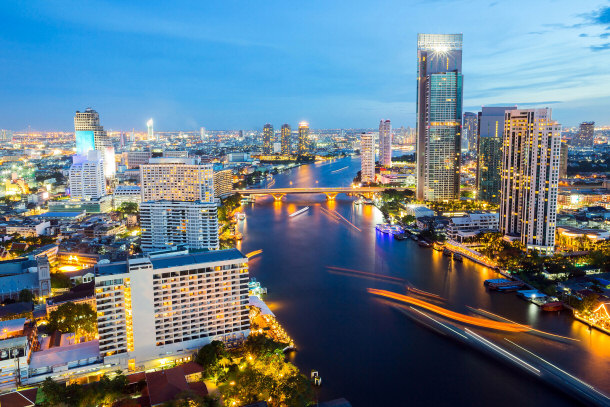
In 1984 the British musician and actor Murray Head, along with the Swedish
singer Anders Glenmark, proclaimed that “one night in Bangkok and the world’s
your oyster”. Now, even though the Mass Communications Organization of Thailand
banned the song in 1985 due to its negative connotations of the city, there is
some truth to this lyric. The capital city of Thailand is a flourishing center
of vast contrast and is predicted to be the city with the most international
visitors in 2013, according the Global Destination Cities Index forecast.
From culture to shopping and to spirituality, take your pick of what draws
your attention the most.
15) The Robot Building
Yes, you read that correctly. Bangkok might not be Tokyo in regards to
unusual and futuristic references to technology, but with this architectural
piece from 1986 certainly has the charm. Located in Bangkok’s business district
Sathorn, the building has played host to the United Overseas Bank since 2005 and
was originally commissioned by the Bank of Asia. Its architect Sumet Jumsai na
Ayudhya was in fact, unsurprisingly, inspired by a toy robot belonging to his
son. If you are a bit pressed for time and still want to see an unusual sight,
see if you can make a small detour over a road tangent to it.
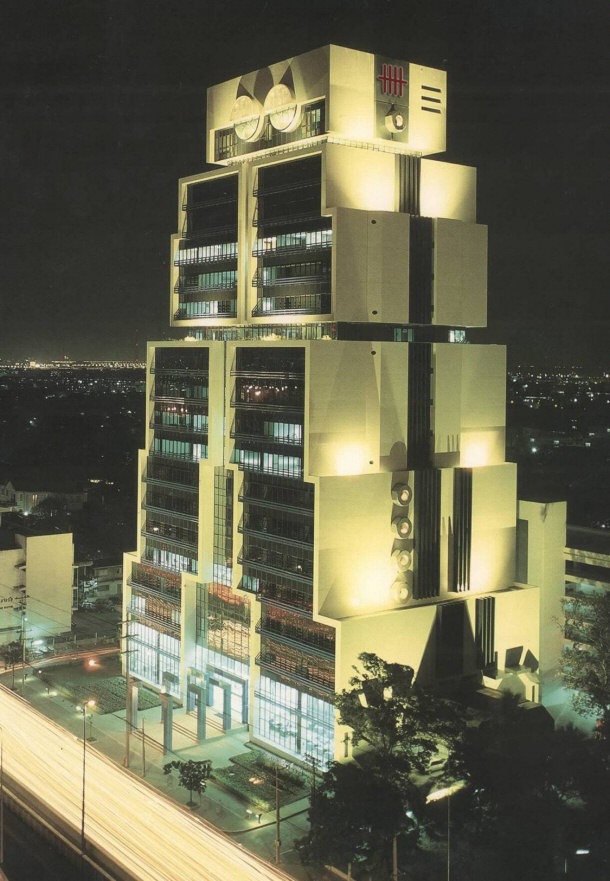
By Sumet jumsai (Own work),
via Wikimedia Commons
As a building with 20 floors, the Robot Building isn’t one of the most
dominant features of Bangkok’s skyline, but it can still be easily seen from Silom Road.
14) The Elephant Building
After the Robot Building, this one doesn’t come by quite as shocking.
Partially located in the North Bangkok Business District and in Chatuchak – a
district that will be mentioned again at a later point – the Elephant or Chang
Building is so distinctive that it was placed fourth in CNNGo's top 20 list of
the World’s Most Iconic Skyscrapers in 2011. But the question is, why an
elephant? The elephant, specifically the Asian elephant, is Thailand’s national
animal and symbolizes good luck, wisdom, power and peace. Although to elaborate
on the importance of the elephant in Thai culture would be a bit excessive, just
know that they are of great importance to the history, culture and religion of
Thailand. The Elephant Building won’t be the first depiction of the animal
you’ll see in Bangkok and certainly not the last.
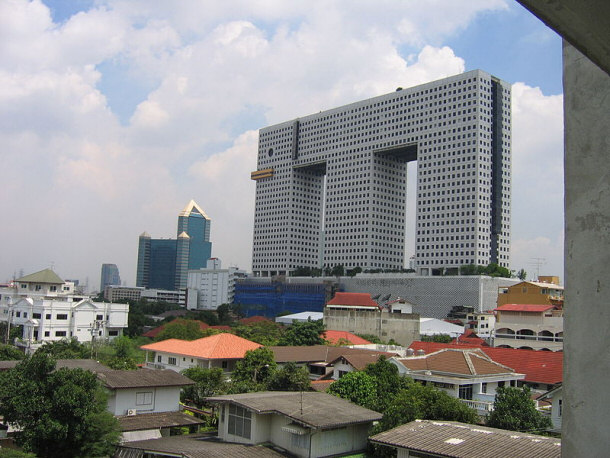
By Jarcje (Own work),
via Wikimedia Commons
Unlike the Robot Building, it has a bit more to offer than ‘just’ an unusual
design. Consisting of three towers, of which two are office spaces and one
residential, the Elephant building also houses a swimming pool, gardens, a bank,
post office, parking garage, and a shopping area. The top most floors that connect the three
towers house expensive residential suites. In total, the Elephant Building has
32 floors and the first connected floor is to be found on the 25th.
13) Hawker Stalls and Restaurants
Let’s talk about one of the most beloved past-times in Southeast Asian
culture: food! Covering a city that occupies over 600 square miles, just
thinking about all the places to visit is going to make you hungry at some
point. A great advantage of cities like Bangkok is that you literally can find
food on every corner. If it isn’t in the form of a restaurant, then most
definitively in that of a hawker stall. They all vary in what they have to
offer, ranging from traditional Thai to international foods, sweets, pastries,
and even drinks. Most unusual, at least to tourists, among what is offered would
be the stalls offering to stir-fry fresh insects of your choice. Now, you don’t
have to necessarily go ahead and try one of the crispy fried creepy crawlies,
even if the vendor is most enthusiastic about offering them to you, but taking a
peek is interesting and really doesn’t hurt – promise!
Typical Bangkok Hawker Stalls (Street Food)
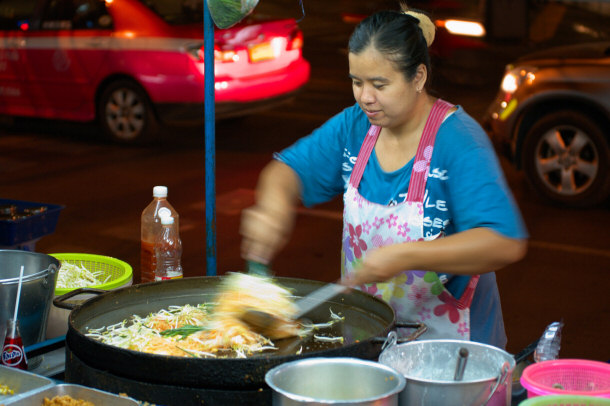
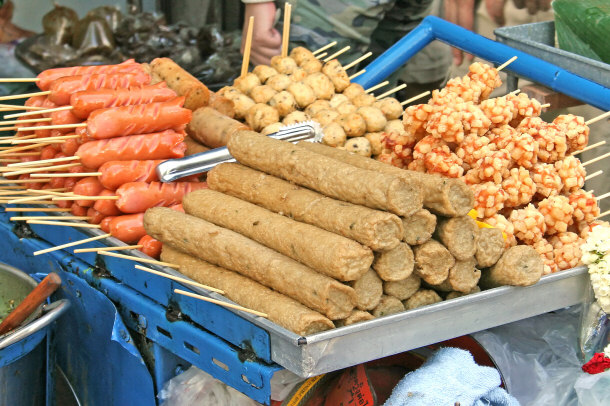
Should you have enough of
sampling your way through Thai cuisine on the road, you can head for one of the
many restaurants within the city. Thailand might not be a huge country when
compared to some others on the world map, but it has its regional tastes just as
well. You can try the northeastern kitchen with its salads, grilled meat, and
sticky rice at restaurants like Isaan Rot Det or go for the spicier, southern
variant at Ruen Mallika. If you’re really into traditional Thai home cooking,
take a peek at Chote Chitr and Taling Pling.
12) Siam Square
Fashion isn’t necessarily dominated by the French and Italians. Siam Square
is the main home of independent Thai fashion, and several native designers have
set up shop there. Located near the central Chulalongkorn University, Bangkok’s
shopping mecca is not really a square, but a small area filled with shops and
malls, mainly catering to young adults due to its close proximity to the
university.

Over all, if you’ve planned ahead and brought a relatively empty
suitcase with plans to fill it up, Siam Square is where you should go. Make sure
to save some tax money by asking the sales assistant to fill out a VAT Refund
Form and attach the tax invoice and inform yourself on the exact procedure of
getting your VAT refund. Should your travel plans be of a less splurging nature,
you still won’t be able to avoid Siam Square.
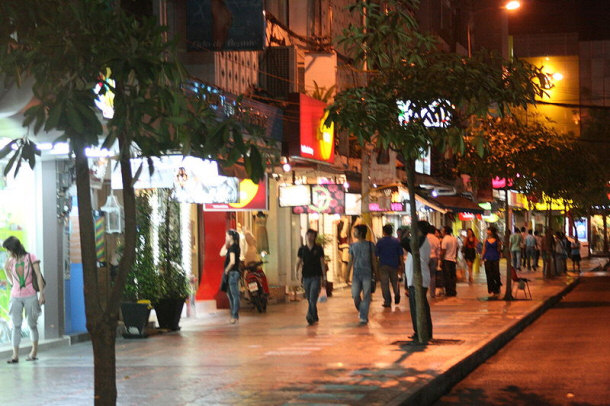
By Sry85 (Own work),
via Wikimedia Commons
Located in its vicinity are some other places on this list like the Jim
Thompson House and the
Bangkok Art and Culture Center. Other nearby sightseeing spots are Madame Tussauds, the Queen Savang Vadhana
Museum, Siam Ocean
World (the largest aquarium in Southeast Asia), a Hindu shrine, and a
Thai temple.
11) Jim Thompson House
James Harrison Wilson Thompson was an Office of Strategic Services operative
who is best known for being the co-founder of the Thai Silk Company and for his
vanishing act in Malaysia’s Cameron Highlands. He came to Thailand was after
Japan’s surrender at the end of World War II and was involved with the
organization of the local OSS office. After leaving the army in 1946, Jim
Thompson became involved in reviving the Thai hand-woven silk industry and
founded the Thai Silk Company with George Barrie. For the Thai people, the
company’s success, which reached full acknowledgement when its products were
used for the costumes in the musical The King and I, meant that thousands could
escape poverty. Most importantly for the Jim Thompson House in Bangkok, he was a
collector of Thai structures and worldly and religious Asian art that now can be
found at this museum.
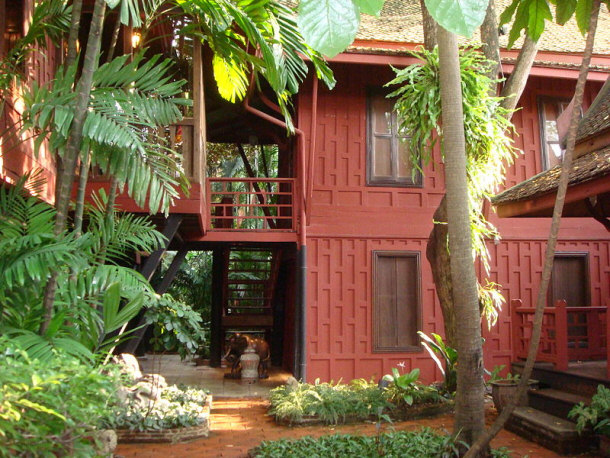
By Millevache (Own work),
via Wikimedia Commons
Fun fact: while working for the US Legation, Jim Thompson was colleagues with
Kenneth Landon, whose wife wrote the book Anna and the King of Siam, which later
inspired the King and I.
10) Wat Kalayanamitr
Even though Wat Kalayanamitr is a bit off the classic tourist trails, it can
still be easily found as it is located on the river bank and in the old port
district. The temple, besides being interesting in architecture, houses three
national records.

One being the biggest sitting Buddha, which is why it also has
the highest roof finial and Thailand’s biggest bell. The sitting Buddha statue
is 45 feet wide and 147 feet tall. Put into relation, the Buddha statue is as
wide as the Hollywood sign is high and just a bit shorter than half a football
field.
Gigantic Buddha Inside Wat Kalayanamitr
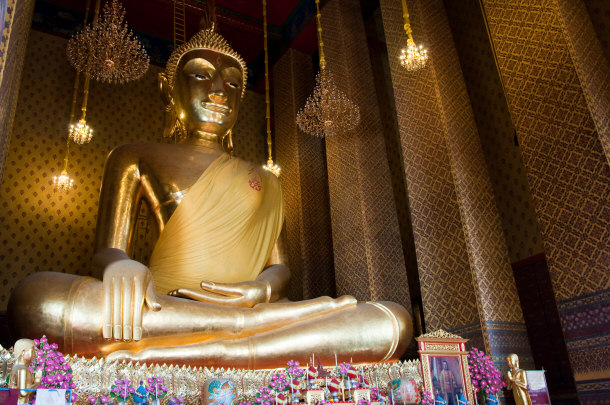
You might want to remember those numbers for the following temple.
9) Wat Pho
The Temple of the Reclining Buddha belongs to Bangkok’s biggest temples. The
name of this temple is accurately chosen: the complex houses a 45 foot tall and
138 foot long reclining Buddha covered in gold leaf. This impressive statue
alone is a good reason to visit Wat Pho. In the hallway just after the entrance,
where you can buy a bowl of coins, you’ll find 108 bronze bowls to drop
coins in.
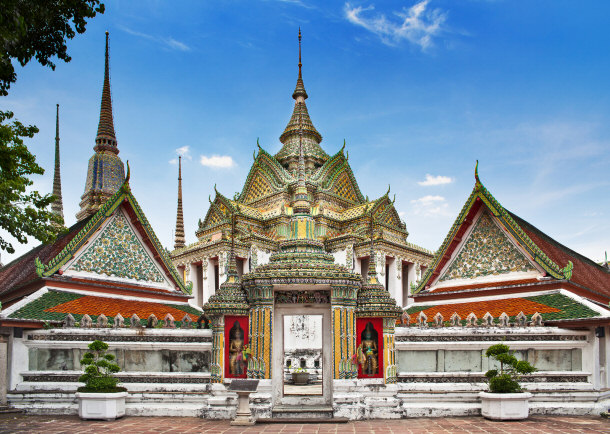
Doing so is said to bring good luck and even if you’re not the
superstitious type, you’ll be doing a good deed. The coins in the bronze bowls
are used to support the monks in their task of renovating and preserving the
temple. To sweeten up your visit, it’s also known as the place where the
traditional Thai massage first began and you can get one there. Before Wat Pho
was a temple, the location of it was where people were educated in traditional
Thai medicine and till this day the temple is pretty much the first public
university in Thailand.
A Relief Inside Wat Pho
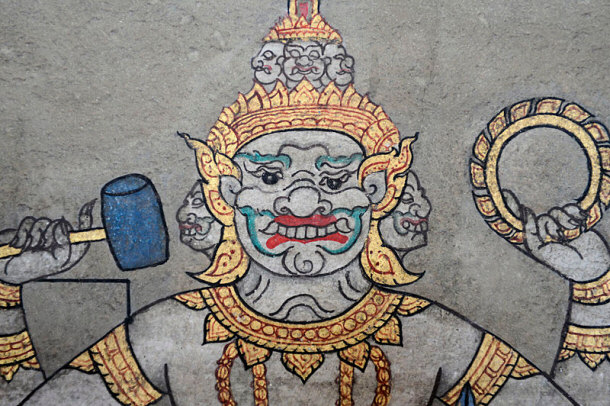
By Godot13 (Own work),
via Wikimedia Commons
Belonging to the temple complex is the open air hall of
the Traditional Medical Practitioners Association Center, where the technique of
Thai massage is taught.
8) Yaowarat - Chinatown
When you’re exploring the north of the Old city, you can’t miss entering
Chinatown. The entrance is marked by a large and very classical ceremonial
Chinese gate, and beyond, you’ll feel like you’ve entered another world.
Map of Yaowarat
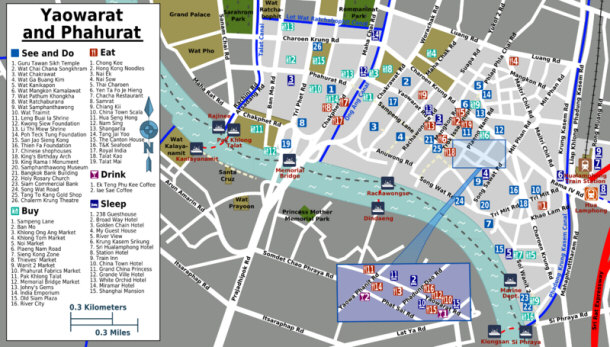
By Globe-trotter (Own work based on OpenStreetMap.org [1].),
via Wikimedia Commons
Chinatown is where the Chinese community in Thailand has preserved its culture
and lifestyle since their relocation from Ko Ratanakosin in 1783. The most
distinguishing mark of Chinatown is how it seems to have completely avoided the
surrounding urbanization with its narrow roads and alleys.
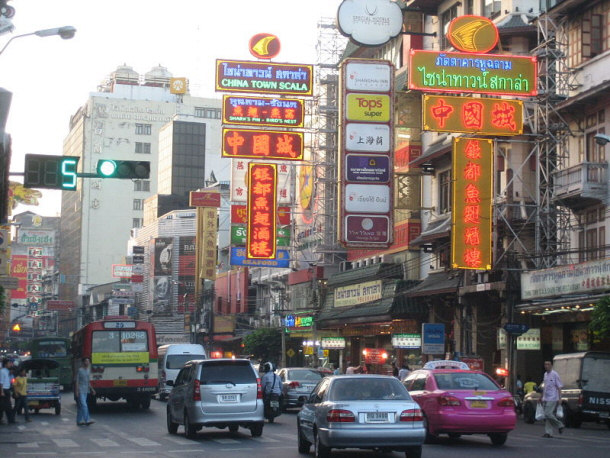
By Naoto Nojima (Picasa Web Albums [1]),
via Wikimedia Commons
Whatever you’re
looking for, be it food, an unusual shopping experience beyond the classic malls
and shopping centers, or simply some contrast to what lies beyond Chinatown’s
bubble of existence, you’re very likely to find it here. If you arrive in the
timeframe of certain Chinese festivals, you can also be treated to traditional
celebrations like a lion dance during Chinese New Year or try some moon cakes
during the autumn Moon Festival. Most importantly, if you’re trying to shop a
bit cheaper, Chinatown is the best place for some good old bartering and
haggling.
7) Lak Mueang
Technically, a Lak Mueang (city pillar) can be found in almost every city in
Thailand and contains a shrine in honor of the city spirit deity. Although
beautiful in classic Thai architecture and of historical value due to most
likely being built by King Rama I in 1782, what makes the Lak Mueang of Bangkok
really interesting for you to take a longer look than the usual building
photography trip are the traditional dances held at regular intervals.
Traditional dances, categorized into classic and folk, are considered a major
art form in Thailand. The dances you can see in a Lak Mueang are of the classic
style and here you’ll see the performance of an excerpt of a slower dance called
Lakhon Chatri, which has its roots in traditional Malay dances.
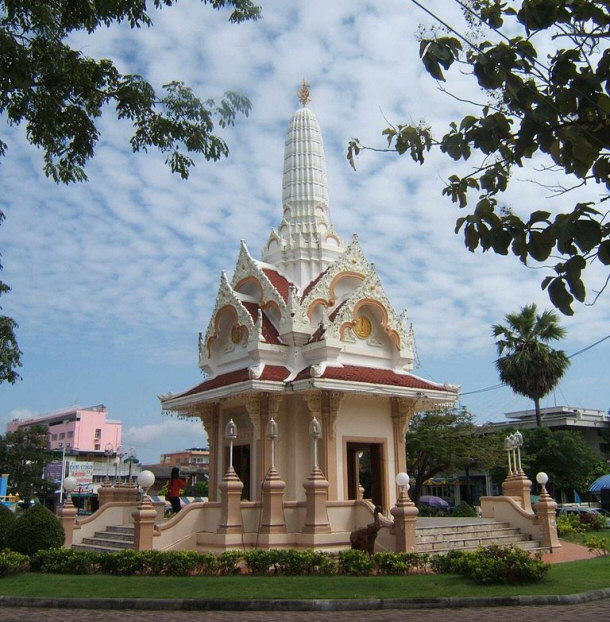
By Media lib (Own work),
via Wikimedia Commons
You needn’t
worry if you miss the date of a certain dance as they are performed several
times throughout the day, as local dancers are paid by worshippers of the spirit
deity. There are other possibilities to experience the magic of traditional Thai
dances, if you’re feeling like you want to see the whole span of different types
during your stay or if you’re visiting again and want to vary things a bit. Most
notable would be the Khon masked dance, which you can experience in combination
with a good meal at the Sala Thai restaurant.
6) Chatuchak Weekend Market
Should you be looking for something to bring back home other than the boring
tourist t-shirt and really don’t want a friend wearing that “My friend went to
Bangkok and all I got was this lousy t-shirt”, then the Chatuchak Weekend Market
is the place to visit. Noteworthy traditional Thai crafts found in stores there
are cutlery from forged steel, shadow theater puppets, brassware, Thai silk, and
woodcarving. Most importantly, you won’t have to worry about buying a product
that just came off a factory production line quite as much.
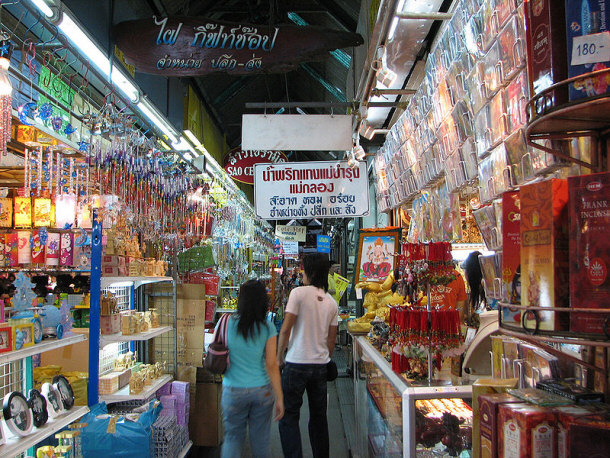
By edwin11_79,
via Wikimedia Commons
Thai souvenirs are
trending more and more to originality and local products, supporting local
artisans and manufacturers. If you’re not quite sure if the product you’re
interested is adherent to these beliefs, look out for the OTOP logo, marking an
item as village goods. In general, the Chatuchak Weekend Market serves a variety
of goods beyond crafts and souvenirs, so even if you’re not quite ardent about
getting those, the market is worth a little milling.
5) Bangkok Art and Culture Center
To get a look at how contemporary Thai art is progressing, be sure to visit
the Bangkok Art and Culture Center. Due to its central location in downtown
Bangkok, it’s easy to find and visit, not to mention hard to overlook with the
current huge statue of what is described as a space woman displayed in front of
it. The BACC aims to be a place where culture is easily accessible to everyone
through programs for all media: music, theater, art, film, and design.
Additionally, it houses an art library. Also, it regularly plays host to events
of cultural and educational nature.
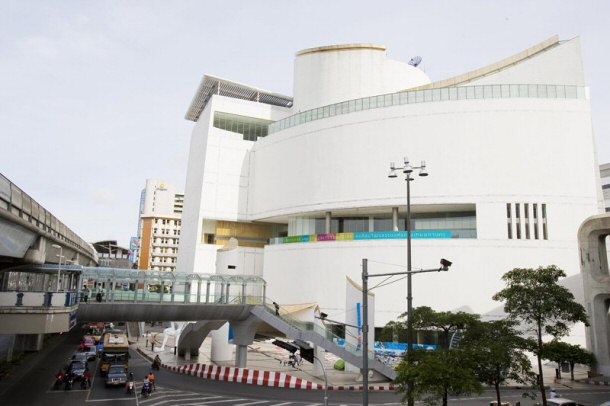
By Cush2k (I took it at Phatumwan junction),
via Wikimedia Commons
For visitors, it’s interesting to check what
the current exhibit is prior to visiting and see how much time you plan on
spending. If you have that, give yourself some room, because you’ll be very
likely to get hung up in the many other things to do such as bookshops, one of
the restaurants, or the café.
4) The Traditional Thai Puppet Theater
Shadow theater, or Nang Yai in Thai, is another long standing drama tradition in
Thailand, going as far back as the fifteenth century. Though it was on the verge of vanishing from people’s
consciousness in the shadow of the modern movie. That might be one of the
reasons why the Traditional Thai Puppet Theater is under the patronage of the
Royal family today. Similar to a movie, a large white screen is used. A light is
placed behind this screen, traditionally a fire, and the performers use large
and heavy puppets made from buffalo hide. The performance is accompanied by a
band, and the story is told in form of songs and chants. The main source of the
story is the Thai national epic “Glory of Rama”, which is based off the Hindu
Ramayana, and you might be familiar with several depictions of singular scenes
because it is a wide-spread topic in traditional Thai art.
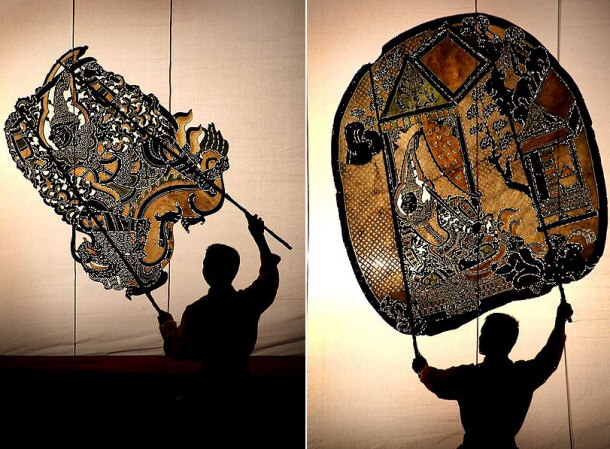
By Steve Evans from Citizen of the World,
via Wikimedia Commons &
Second Photo
Because the epic
itself is far too long to play in one sitting, Nang Yai performances break the
story into single episodes. Even if the performances are traditionally held in
Thai, making understanding them a bit difficult, there’s something magical about
the elaborate puppets’ shadows dancing in front of a flickering light. A shadow
theater show can be a unique experience to add to your list of things to do.
3) The Floating Markets
You’ll remember seeing references to one of the Floating Market in quite a
few movies. Narrow long boats with one or two passengers wedged between piles of
fresh fruits, vegetables, and food, which is sometimes even cooked on the boats,
all trying to maneuver along a narrow river road. In and around Bangkok you’ll
find four major floating markets: the most popular ones, Damnoen Saduak and
Amphawa, and the remaining two, which are considered to be more authentic,
Taling Chan and Khlong Lat Mayom. Whichever you prefer, you’ll experience each
the best in the morning hours, when it isn’t quite as hot and the most vendors
are floating along.
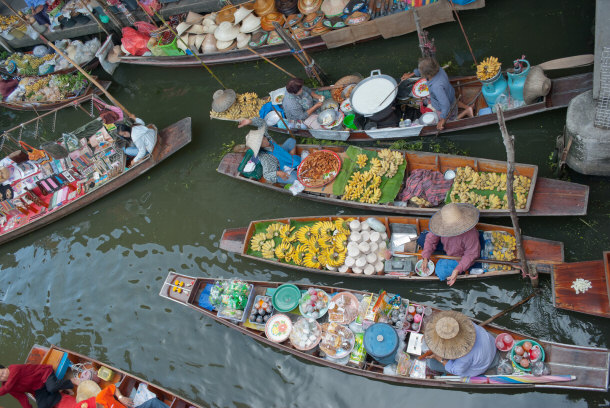
It may be hard to believe with the amount of international
visitors the floating markets experience, but there was a time, long before the
majority of Bangkok’s waterways were being built over, when this was where
locals would do their daily grocery shopping. There was an entire phase in Thai
history during which floating markets had all but vanished from daily life. Only
in 1987, when Chamlong Srimuang, the governor of Bangkok back then, reinitiated
them in honor of the 60th birthday of King Bhumibol, did these historical
features return to Bangkok. It’s a good thing they did, as visiting a floating
market, even if you aren’t planning on buying anything, is a wonderful
experience that will make you feel like you just stepped back in time.
2) Wat Arun/Chaeng – The Temple of Dawn
The iconic architecture of the Temple of Dawn will very likely feel very
familiar to you. Located on the west bank of the Chao Phraya River, the Buddhist
temple paints an exotic and majestic picture with colorful decorations of
colored glass, seashells and porcelain adorning its spires, of which the over
210 foot high one on the bank is considered to be a world-famous landmark.
According to legend, King Taksin arrived at the temple upon the break of dawn in
the mid-18th century, after fighting his way through the Burmese army in
Ayutthaya.
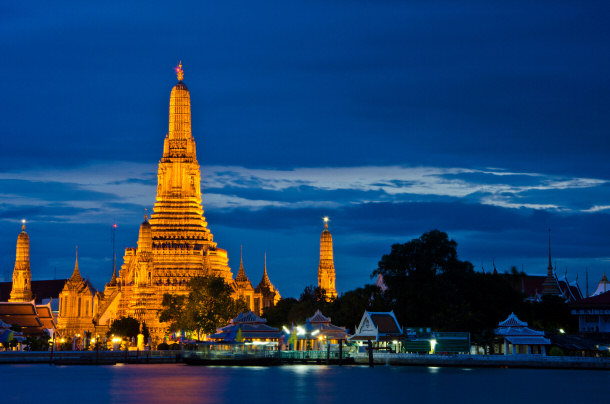
Later, after the Ayutthaya kingdom fell, he instigated renovations
and renamed the temple to the name it’s referred to by the locals – Wat Chaeng.
Befitting the name, you’ll have the most breathtaking view of the temple when
you experience it during dawn hours, or alternatively, during sun set, when the
sunlight reflects on the glass and porcelain ornaments. Other noteworthy
features of the Wat are the Chinese soldier and animal figures situated around
the base of the spires. When you’re planning on entering the Wat during your
stay, make sure to dress accordingly in respect to Buddhist belief. This means
that you should cover your shoulders and make sure to show no skin above your
knees. Also, it is common practice to take off your shoes before entering a
temple.
1) The Grand Palace and Wat Phra Kaew
Located in the Old City, the Grand Palace and the nearby Temple of the
Emerald Buddha are Thailand’s most sacred locations and are the top places to
visit, especially if you’re in Bangkok for the first time. Even if the palace
hasn't been the home of the Royal family, nor host of the royal government,
since the 20th century, it is still used for ceremonies and celebrations. Part
of the complex is the former buildings of the Thai ministry, the state
departments and the mint. Besides the imposing appearance of the palace itself
and varying architectural styles of the other buildings, Rattanakosin Island,
upon which the Grand Palace and Wat Phra Kaew are to be found, is decorated with
beautiful gardens, courtyards, and pavilions.
The Grand Palace and Wat Phra Kaew
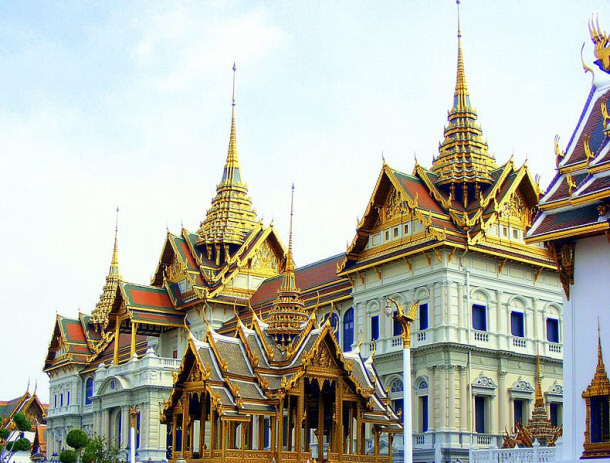
By Tevaprapas Makklay,
via Wikimedia Commons
All of them were imagined by one
of the many kings of Thailand’s history. So exploring the island is not only
impressive, but is the best way to see a vast selection of historical styles.
Construction on the palace began when King Rama I moved the Thai capital from
Thonburi to Bangkok, after Rattanakosin Island was artificially created by the
digging of canals. The Palace can be sorted in to smaller areas, making your
visit less confusing if you go through one part at the time. A royal chapel was
built, and now this chapel has become the temple housing the famous Emerald
Buddha. What makes this statue so noteworthy is that it has been made out of a
single slab of green nephrite, despite the confusing name, and it is said to be
over 2000 years old. Modern analysis however, dates the Buddha statue back to
the fifteenth century. Legend states that the Emerald Buddha went on a small
odyssey from India to Burma, Cambodia, Laos, and only then to finally be housed
in Thailand.
Side View of The Grand Palace and Wat Phra Kaew
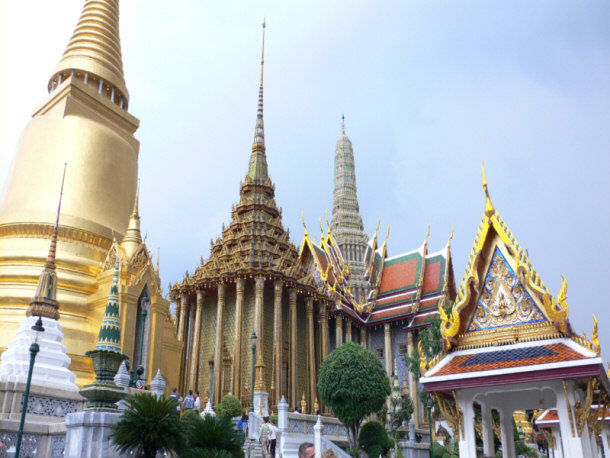
By Khemkhaeng (Own work),
via Wikimedia Commons
Depending on the season, the Emerald Buddha will wear different
robes, which are changed in a ceremony by the ruling King of Thailand. For the
Thai people, this is a very important date in their calendar, and, if you plan
your visit right, you might come right on time. The festivals celebrated in the
Grand Palace complex are just as colorful as Thai architecture and is
accompanied by music, food, and dance. On some occasions, members of the Royal
family will travel down the river to the Grand Palace in an artfully decorated
boat.
Final Thoughts
No matter what your main reason for visiting Bangkok, it is a guarantee that you’ll find something to suit your tastes. Most importantly,
take your time and be curious. The Thai people are very kind and helpful, so if
you are lost in this big bustling city, don’t be afraid to ask for some
assistance. Especially if you are the type who’s curious about Bangkok from a
local perspective, you can ask at your hotel reception or one of the many
shopkeepers to recommend you something. Just make sure to pick up some
literature on the dos and don’ts of Thai culture. The last thing you want to do
is disrespect the royal family. Last but not least, a safe trip and enjoy your
stay!
Vacation Destinations
Top Lists:
Top 15 Interesting Places to Visit in the Bahamas
Top 15 Fun Things to Do in Miami, Florida
Top 15 Fun Things to Do in Chicago
Top 15 Best Unknown Things to do in Las Vegas
Top 15 Fun Things to Do in Hollywood
Top 10 Best Places to Visit in Turkey
The Top 15 Best Things to Do and See in Sydney
Top 10 Things to Do in Edinburgh
Top 10 Things to do on Oʻahu
Top 15 Things to Do in Albuquerque
Top 15 Interesting Places to Visit in Spain
Top 15 Places to Visit in New York City
Top 15 Things to Do in Portland Oregon
Top 15 Things to do in Greece
Top 15 Places to Visit in Houston Texas
Top 15 Interesting & Safe Places to Visit in Mexico
Top 15 Interesting Places to Visit in the Netherlands
Top 15 Interesting Places to Visit in Thailand
Top 15 Interesting Places to Visit in Switzerland
Top 15 Interesting Places to Visit in Portugal
Top 15 Places to Visit in San Francisco
Top 15 Interesting Places to Visit in Shanghai
Top 15 Interesting Places to Visit in Puerto Rico
Top 15 Interesting Places to Visit in Norway
Top 15 Interesting Places to Visit in Las Vegas
Top 15 Interesting Places to Visit in Jamaica
Top 15 Interesting Places to Visit in Croatia
Top 15 Interesting Places to Visit in Belgium
Top 15 Interesting Places to Visit in Bangkok
Top 15 Things to Do in Rio de Janeiro
Top 15 Things to Do in Monaco
Top 15 Interesting Places to Visit in Dubai
Top 15 Interesting Places to Visit in Amsterdam
Top 15 Things to Do in New Zealand
Top 15 Interesting Places to Visit in Paris
Top 15 Interesting Places to Visit in Italy
Top 15 Interesting Places to Visit in Singapore
Top 15 Most Interesting Places to Visit in Berlin
Top 15 Best London Attractions
15 Little Known Facts About New York City Disney World Articles
Top 15 Disney World Rides for Adults
Top 15 Disney World Rides for Kids
Top 15 Disney World Resorts for Adults
Top 15 Disney World Resorts for Kids
15 Fascinating Facts About Disney World
Top 15 Fun Things to Do at Disney World’s Animal Kingdom
Top 15 Fun Things to Do at Disney's Hollywood Studios
Top 15 Fun Things to Do at Disney World's Epcot
Top 15 Fun Things to Do at Disney World’s Magic Kingdom
Shorter Top Lists:
Top 10 Tourist Attractions in San Diego
Top 10 Tourist Attractions In India
Top 10 Things to Do In Kansas City
5 Places You Should not Miss in Brazil
Top 5 Things to do in New York City
Informational:
Best Tourist Attractions In Vietnam
Taking in the Sights in Shanghai
Top Tourist Attractions in Perth, Australia
Nice places to visit while in Great Britain
Sampling the Foods at the Night Markets in Taipei
What to do for a Kenya Vacation
Best Attractions in Victoria, B.C.
Photos of the Luxor Hotel in Las Vegas
|